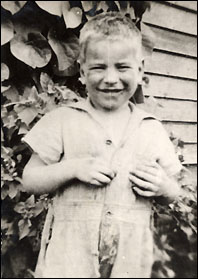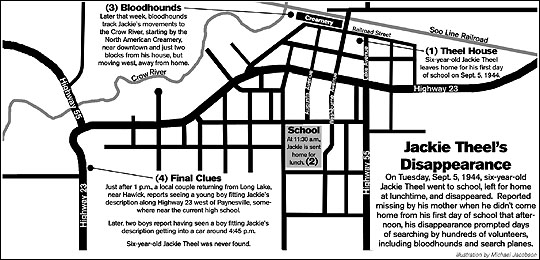The Mystery of Jackie Theel
As far as anyone knows, he did not eat lunch either.
Jackie Theel attended only a half day of school. He left school to walk home for lunch that day and disappeared. "He was in first grade, his first day of school. He was supposed to come home for lunch, but we never saw him," said Fay, his younger brother, who was four-years-old when Jackie disappeared.
 "When he didn't come home from school, that's when (mom) called the sheriff," said his sister Annabelle (Theel) Krupke, who was 16 when Jackie disappeared.
"When he didn't come home from school, that's when (mom) called the sheriff," said his sister Annabelle (Theel) Krupke, who was 16 when Jackie disappeared.
This picture of Jackie Theel was used in news stories and missing persons reports after his disappearance in Paynesville in September 1944.
"I didn't think it was that big of deal," Annabelle continued, of her first reaction to her brother's disappearance. "In a town the size of Paynesville, I figured someone would see him."
But the mayor and several businessmen could not find Jackie. Then, everybody looked.
For days, family members, Boy Scouts, businessmen, farmers, and hundreds of volunteers searched for Jackie. Farmers were asked to look on their property. Every building in town was searched. The Civilian Air Patrol brought a plane to town to help the search, and bloodhounds were used to trace Jackie's movements.
"It seems to me that the town of Paynesville was pretty much closed down for three days," said Fay, who now lives on Highway 23 between Roscoe and Richmond.
There was nice weather on the first day of school that year, recalled Annabelle. Then, when they started searching for Jackie the next day, the weather turned cold, rainy, and nasty, she said.
His disappearance was statewide news, covered by the daily newspapers and radio.
Clues in the case were few.
Jackie Theel, wearing a blue-and-white sailer's suit, walked from the Theel house - which stood on the corner of Lake Avenue and Railroad Street, a block west of downtown, now an abandoned lot - to school. In 1944, the school was located where the current elementary school stands now.
At 11:30 a.m., his teacher sent Jackie home for lunch, asking him if he knew the way home before letting him go.
Then, according to bloodhounds that later tracked his movements, he walked down Augusta Avenue, a block west of Washburne, when the Theel house was located a block east of Washburne. The bloodhounds tracked Jackie to the Crow River, just west of the North American Creamery (now AMPI). There, the tracks of a small boy were found, going west along the river.
The bloodhounds found Jackie's scent on the west end of town along Highway 23, which ran along the same path in 1944 that it does today. But then the scent disappeared, just like Jackie.
A couple returning from Long Lake, near Hawick that day, reported seeing a small boy wearing a blue suit standing along Highway 23 around 1 p.m. that afternoon.
And, later that evening, two local boys reported seeing "a small boy enter a light grey car on Highway 23" around 4:45 p.m., the Press reported in September 1944.
According to his missing person's description by the Bureau of Criminal Apprehension, Jackie was 37 inches tall, weighed 45 pounds, had blue eyes, blond hair, and a medium build when he disappeared.
"They had no clues," said Fay about the mystery. "They had searched everywhere they could."
Almost immediately, too, rumors started to fly. Annabelle and Fay, in the 60 years since their brother disappeared, have heard all the stories: that Jackie was kidnapped, that he drowned, that their father killed him, that their father sold him, etc.
Unfortunately, parents are suspects in these types of cases because sometimes they are responsible. But their father, according to Annabelle and Fay, was not home the day that Jackie disappeared. He was a trucker and had to be called in South St. Paul to come home, they said.
That did not keep him from being a suspect, though. Their father, Harold, was a loner, said Annabelle. "A man of few words," according to his cousin Manford Theel, who still lives in Paynesville.
They later found bones in the family well, said Annabelle, but they proved to belong to a dog.
And, as to the rumor that their dad sold Jackie, if their dad could have sold kids for $500, he should have sold more, said Annabelle with a laugh. After all, their family did have 15 kids but little money in those days. "You could buy a piece of candy for a penny, and no one had a penny," said Annabelle.
Annabelle and Fay don't believe their brother drown, either. "If he would have drown," said Fay, "they would have found his body eventually."
While their father never showed much emotion, their mother was traumatized by Jackie's disappearance, according to Annabelle and Fay. "Ma turned grey overnight," said Fay. "She had salt-and-pepper hair, but she turned white practically overnight."
His mother was still upset about Jackie's disappearance in the nursing home, said Fay, and it was "always a sore spot."
"You don't get over something like that," added Annabelle.
"I'd say, after 10 or 15 years, they never said a word about it," said Fay. "It was alwa
ys on my mother's mind." "You can only hash over something like that for so long," said Annabelle, especially when they are no answers.
Jackie Theel's real name is Victor John, but the family always called him "Jackie," said Annabelle and Fay. Their mother never revealed his real name, said Fay, so she could use it to identify him if he ever came home.
Their parents, Annabelle and Fay believe, always blamed the teacher for letting Jackie walk home alone. Their mother had sent a note that morning telling the new teacher to keep Jackie at school until a brother picked him up to walk home with him for lunch.
According to the Press articles from September 1944, the teacher asked Jackie if he knew the way home and he pointed. But another news article said Jackie pointed west when the teacher asked him if he knew the way home, while the Theel home was northeast of the school building.
A year later, Fay started school. But a few days before his first day, his mother walked him to school and then pretended to be lost, forcing him to find the way home, he said. Their mother never again allowed anyone to wear a sailer suit, which Jackie was wearing when he disappeared, said Fay.
 Jackie was "quiet" and a "homebody," according to Annabelle.
Jackie was "quiet" and a "homebody," according to Annabelle.
Annabelle and Fay were told that Jackie was "slow," though it is not clear what that means. That word used to be used to indicate someone who was mentally challenged, though neither Annabelle nor Fay think Jackie was severely retarded, since he was sent to school.
What they do remember clearly is that Jackie was not allowed to go far from home. "They never let him go anywhere," said Annabelle. "I think he pretty much stayed home."
Though the kids always did the errands, their parents never sent Jackie uptown to buy groceries, said Annabelle.
The kids would have to get water, fetch milk from a farm on the outskirts of town, and would go to their aunt's house, added Fay. "I knew that town backwards," said Fay.
But, Jackie did not, they agreed.
So, if Jackie had tried to walk home from school that day, and gotten lost, even if it looked familiar, he probably would not be able to find his way home, said Annabelle.
Annabelle and Fay believe that the bloodhounds traced their brother's movements. That he probably tried to walk home but ended up two blocks west of their house and was lost. Then he followed the river to the west end of town, where two eyewitness reports place him along Highway 23.
By then, said Annabelle, he probably would have been crying, and he might have been an easy target.
"I tend to believe that someone saw him wandering and picked him up," said Annabelle. "I don't see how it could have been anything else."
Fay, too, believes that Jackie was most likely kidnapped. At the time, soldiers could get out of the army if they had dependents, which could have been a motive, he said.
Both Annabelle and Fay are suspicious of the sighting of car picking up a boy wearing a sailer's suit and looking like Jackie on the same day he disappeared. That someone else would be spotted in Paynesville who was dressed like Jackie and looked like Jackie on the same day he disappeared is quite a coincidence, according to Annabelle and Fay.
Two local boys saw "a small boy enter a light grey car on Highway 23" at 4:45 p.m. that afternoon, according to the Press from Sept. 14, 1944. The Press reported that the Willmar Police checked this lead and found that the driver was a soldier traveling with his brother who stopped in Willmar to get his starter fixed.
But both Annabelle and Fay wonder what the Willmar Police did to check that lead and find it odd that no one who knew Jackie was asked to identify that "brother."
The Willmar Police Department does not have records dating back to the 1940s, according to their records department. And the newspaper accounts from 1944 raise some questions for Annabelle and Fay.
If the local boys did not report seeing that car until Tuesday evening, was the car still in Willmar? If not, did the police actually speak to that driver and see his "brother"? Or did they just ask about the car the next day and were told at the garage that the man was a soldier who said he was traveling with his brother?
Annabelle got a letter from a former Paynesville school teacher who reported seeing someone that resembled a Theel getting off a navy ship in California in the 1960s. He signed his name, "Jackie Theel," and told the teacher that he had been adopted. Was that their brother?
"It's impossible to know," said Fay about his brother's fate. "You don't know if he's dead or alive."
In the 1980s, Fay was told that a man came to Tuck's Cafe in Paynes-ville, looking for his family, but could not find any Theels in the phonebook.
Though he reported this story to the FBI, which was the last time he was in contact with law enforcement about his brother's disappearance, Fay and Annabelle have doubts about the story. First, there were Theels in the Paynesville phone book in the 1980s, and second the man reportedly talked to an old-timer who would have known some Theels still in town.
Whatever happened to their brother - who would now be 66 years old, if alive - Annabelle and Fay hope for the best. "Hopefully, he had a good life," said Annabelle. "That's all we've ever said."
Since Jackie was only six and did not have any assets and no reason to be declared dead for estate purposes, he is still listed as missing.
Fay, though, recognizing that the people who knew Jackie as a child are getting scarce, thinks it may be time to honor his brother. Fay is considering putting a memorial to his brother in the Salem Cemetery. It would read something like this:
Jackie Theel Born: February 15, 1938
Missing: September 5, 1944
Contact the author at editor@paynesvillepress.com • Return to News Menu
Home | Marketplace | Community